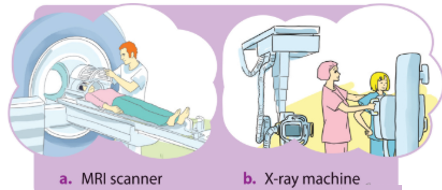Bài học cùng chủ đề
Báo cáo học liệu
Mua học liệu
Mua học liệu:
-
Số dư ví của bạn: 0 coin - 0 Xu
-
Nếu mua học liệu này bạn sẽ bị trừ: 2 coin\Xu
Để nhận Coin\Xu, bạn có thể:

Luyện tập SVIP
The machines described in the pictures above help doctors to diagnose and treat diseases. Answer the questions.
– Have you ever seen them?
– What are they used for?


Read an article about the main factors for the increased life expectancy. Four sentences have been removed from the article. Choose a sentence to complete each gap (1 - 4).
Over the past hundred years, the average life expectancy has risen dramatically from 30 years in 1900 to 67.2 years in 2010, with Japan reaching the highest figure at 82.6 years. 1.
Mass media have helped to raise people's awareness of lifestyle choices. While smoking, alcohol intake and fast food consumption can increase the risk of obesity and heart disease, doing regular physical activity and spending more time outdoors can boost the body's strength and ability to function well. 2. . Longevity is also linked with low levels of stress and anxiety. A popular way to relieve stress in today's busy lifestyles is practising meditation and yoga.
In addition to better living standards, people enjoy more nutritious diets and cleaner drinking water. Research shows that the food we eat can affect longevity, and even simple dietary changes can boost our immune system. 3. .
The third factor responsible for the dramatic increase in life expectancy is the advanced technology and medical developments. 4. . In the 21st century, scientists continue to look for new ways to treat serious diseases and slow down the ageing process. Many of these treatments and new developments have the potential to further prolong and improve the quality of life.
(Kéo thả hoặc click vào để điền)
Over the past hundred years, the average life expectancy has risen dramatically from 30 years in 1900 to 67.2 years in 2010, with Japan reaching the highest figure at 82.6 years. 1.This increase can be attributed to three main factors: healthier lifestyles, better nutrition, and advances in medical science and technology.
Mass media have helped to raise people's awareness of lifestyle choices. While smoking, alcohol intake and fast food consumption can increase the risk of obesity and heart disease, doing regular physical activity and spending more time outdoors can boost the body's strength and ability to function well. 2. Studies show that for each hour of regular exercise, people can gain two hours of additional life expectancy. Longevity is also linked with low levels of stress and anxiety. A popular way to relieve stress in today's busy lifestyles is practising meditation and yoga.
In addition to better living standards, people enjoy more nutritious diets and cleaner drinking water. Research shows that the food we eat can affect longevity, and even simple dietary changes can boost our immune system. 3. Eating more fruits and vegetables, but less fatty foods can reduce the risk of serious diseases.
The third factor responsible for the dramatic increase in life expectancy is the advanced technology and medical developments. 4. The last century's advances such as the discovery of antibiotics and vaccines, and the development of medical imaging have contributed to longer life. In the 21st century, scientists continue to look for new ways to treat serious diseases and slow down the ageing process. Many of these treatments and new developments have the potential to further prolong and improve the quality of life.
Find the words or expressions in the text which have the following meanings.
| 1. believed to be caused (by) | |
| 2. the state of being extremely overweight in an unhealthy way | |
| 3. drugs used to kill bacteria and treat infections | |
| 4. a substance that is driven into the blood to protect the body against certain diseases | |
| 5. relating to the food eaten by an individual |
Over the past hundred years, the average life expectancy has risen dramatically from 30 years in 1900 to 67.2 years in 2010, with Japan reaching the highest figure at 82.6 years. 1.This increase can be attributed to three main factors: healthier lifestyles, better nutrition, and advances in medical science and technology.
Mass media have helped to raise people's awareness of lifestyle choices. While smoking, alcohol intake and fast food consumption can increase the risk of obesity and heart disease, doing regular physical activity and spending more time outdoors can boost the body's strength and ability to function well. 2. Studies show that for each hour of regular exercise, people can gain two hours of additional life expectancy. Longevity is also linked with low levels of stress and anxiety. A popular way to relieve stress in today's busy lifestyles is practising meditation and yoga.
In addition to better living standards, people enjoy more nutritious diets and cleaner drinking water. Research shows that the food we eat can affect longevity, and even simple dietary changes can boost our immune system. 3. Eating more fruits and vegetables, but less fatty foods can reduce the risk of serious diseases.
The third factor responsible for the dramatic increase in life expectancy is the advanced technology and medical developments. 4. The last century's advances such as the discovery of antibiotics and vaccines, and the development of medical imaging have contributed to longer life. In the 21st century, scientists continue to look for new ways to treat serious diseases and slow down the ageing process. Many of these treatments and new developments have the potential to further prolong and improve the quality of life.
Read the text again and answer the questions.
1. What are the factors responsible for the increase in life expectancy?
2. What lifestyle choices can increase the risk of heart disease?
3. What can improve the ability of the human body to function well?
Over the past hundred years, the average life expectancy has risen dramatically from 30 years in 1900 to 67.2 years in 2010, with Japan reaching the highest figure at 82.6 years. 1.This increase can be attributed to three main factors: healthier lifestyles, better nutrition, and advances in medical science and technology.
Mass media have helped to raise people's awareness of lifestyle choices. While smoking, alcohol intake and fast food consumption can increase the risk of obesity and heart disease, doing regular physical activity and spending more time outdoors can boost the body's strength and ability to function well. 2. Studies show that for each hour of regular exercise, people can gain two hours of additional life expectancy. Longevity is also linked with low levels of stress and anxiety. A popular way to relieve stress in today's busy lifestyles is practising meditation and yoga.
In addition to better living standards, people enjoy more nutritious diets and cleaner drinking water. Research shows that the food we eat can affect longevity, and even simple dietary changes can boost our immune system. 3. Eating more fruits and vegetables, but less fatty foods can reduce the risk of serious diseases.
The third factor responsible for the dramatic increase in life expectancy is the advanced technology and medical developments. 4. The last century's advances such as the discovery of antibiotics and vaccines, and the development of medical imaging have contributed to longer life. In the 21st century, scientists continue to look for new ways to treat serious diseases and slow down the ageing process. Many of these treatments and new developments have the potential to further prolong and improve the quality of life.
Read the text again and answer the questions.
1. Why do people practise yoga and meditation?
2. Why is diet linked with longevity?
3. What are the medical developments and advanced technology mentioned in the article?
Over the past hundred years, the average life expectancy has risen dramatically from 30 years in 1900 to 67.2 years in 2010, with Japan reaching the highest figure at 82.6 years. 1.This increase can be attributed to three main factors: healthier lifestyles, better nutrition, and advances in medical science and technology.
Mass media have helped to raise people's awareness of lifestyle choices. While smoking, alcohol intake and fast food consumption can increase the risk of obesity and heart disease, doing regular physical activity and spending more time outdoors can boost the body's strength and ability to function well. 2. Studies show that for each hour of regular exercise, people can gain two hours of additional life expectancy. Longevity is also linked with low levels of stress and anxiety. A popular way to relieve stress in today's busy lifestyles is practising meditation and yoga.
In addition to better living standards, people enjoy more nutritious diets and cleaner drinking water. Research shows that the food we eat can affect longevity, and even simple dietary changes can boost our immune system. 3. Eating more fruits and vegetables, but less fatty foods can reduce the risk of serious diseases.
The third factor responsible for the dramatic increase in life expectancy is the advanced technology and medical developments. 4. The last century's advances such as the discovery of antibiotics and vaccines, and the development of medical imaging have contributed to longer life. In the 21st century, scientists continue to look for new ways to treat serious diseases and slow down the ageing process. Many of these treatments and new developments have the potential to further prolong and improve the quality of life.
Which of the factors mentioned in the article do you think is the most importan?

Bạn có thể đăng câu hỏi về bài học này ở đây
